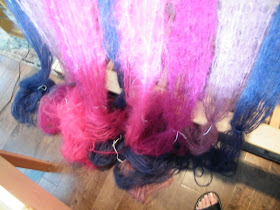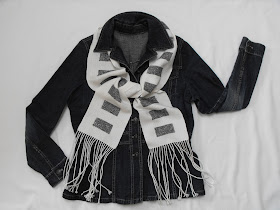I have totally not kept up with the blog and with this post I actually forgot to publish it ~ oops! We have a yearly dye day where we dye silk scarf warps and this year we pulled some warps using Tencel too.
We each pulled three white silk warps with 200 threads in each . Then we used yellow Tencel to make three more warps. We used yellow Tencel because for some reason we had bought two large cones of yellow a couple of years ago and it and the Coral we duplicated are not colours we use often, why did we buy them?!
For the Tencel we pulled three different styles of warps. The first style is 200 threads divided into five groups of 40 threads, then two of the bunches are flipped so that the crosses are at the other end for painting. The second style is 96 threads divided into two groups of 48 threads. The third style is just 96 threads, not sure if we want it for a scarf or a shawl at this point.
It is always surprising how hydroscopic the silk is, it takes forever for it to get completely wet! In the picture you can see that we use weft twinning to keep the warp tidy and flat enough to paint. The flashes of green are painter’s masking tape that we use to label the warps, about half of them fell off though!
We use Procion MX dyes and
the technique can be found here. We like to use sponge brushes to add the dyes. We used the same technique for the Tencel warps.
Here is a picture of the warps batching. We wrap the scarves in plastic wrap and then place them in plastic bags with like colours just in case there is any leakage. We also did some silk scarf blanks. It was a very long day of dyeing.
The next day we rinsed everything. It always looks a little messy!
Here is a scarf freshly rinsed scrunched into a ball. But just a couple of tugs and it is all straight again, like magic.
The scarves are all hung out to dry out of the sun. Don’t they look exciting!
And here they are all finished. We were both amazed at how well the yellow Tencel took the dye. I’m going to describe the colours of each warp and who it belongs to because we will inevitably lose the tag and won’t remember who’s is who’s!
Here are Mum’s three silk warps. The top is Gold, Plum, Moss and Rust/Brown. The middle is Deep Navy Blue, Black and Silver. And the bottom one is Purple, Turquoise, Green and Navy Blue.
Here is Mum’s two Tencel warps. The top is Orange, Red, Brown, Rust and the original Yellow. There are some streaks of green from the brown dye breaking. This warp is 200 threads and has been flip flopped. The bottom warp is both 96 thread Tencel warps, it was getting late in the evening so we combined them. The colours are Navy, Ink Blue, Bright Green, Orange, Red and original Yellow. There are lots of secondary colours like Brown, Purple and Greens.
Here are my three silk warps. The top is Ink Blue and Leaf Green. The middle is Gold, Rust and Bronze Brown. And the bottom one is Plum and Moss.
Here are my two Tencel warps. The top is Orange, Brown, Gold (Sunflower Yellow) and original Yellow. There are some streaks of green from the brown dye breaking. This warp is 200 threads and has been flip flopped. The bottom warp is both 96 thread warps. The colours are Purple, Teal, Green and the original Yellow. There are secondary colours of blues and greens.
Final Garden Shot is the Black Mission Fig. It was such a cold summer that the figs are really late. We only got two weeks of above 25C at the end of August then it was back to the cool weather, it was a truly sucky short summer.






















































